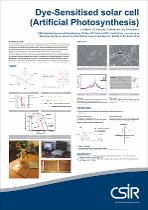JavaScript is disabled for your browser. Some features of this site may not work without it.
- ResearchSpace
- →
- Research Publications/Outputs
- →
- Conference Publications
- →
- View Item
| dc.contributor.author |
Le Roux, Lukas J

|
|
| dc.contributor.author |
Arendse, C

|
|
| dc.contributor.author |
Hietkamp, S

|
|
| dc.contributor.author |
Knoesen, D

|
|
| dc.date.accessioned | 2007-08-07T10:05:50Z | |
| dc.date.available | 2007-08-07T10:05:50Z | |
| dc.date.issued | 2005-07 | |
| dc.identifier.citation | Le Roux, L,K. et al. 2005. Dye-sensitised solar cell (artificial photosynthesis). Annual Conference of the SA Institute of Physics: 51st: 2006: Univ of Western Cape, SA, pp 1 | en |
| dc.identifier.uri | http://hdl.handle.net/10204/1096 | |
| dc.description.abstract | A novel system that harnesses solar energy is the nano-crystalline TiO dye-sensitised solar cell (DSC), in conjunction with several new concepts, such as nanotechnology and molecular devices. An efficient and low-cost cell can be produced by using simple materials. The production process generates very small quantities of residue, resulting in environmentally friendly devices with low energy demanding production techniques. Furthermore, recent developments in the area of sensitizers for these devices have led to the production of dyes that absorb across the visible spectrum leading to higher efficiencies that hold great potential. The CSIR is working towards DSC niche applications, which include alternative energy devices to be used in cell phone chargers, laptops and radio batteries. The prototype solar cells produced at the CSIR have shown promising results and further developments are in the pipeline, which will be elaborated upon in this paper. The formulation of a screen-printable nanoporous TiO paste was developed and no cracks were observed after drying at 450 °C in the furnace. However, the paste has a tendency to become unstable with time. This is evident in the cracking of the thin films various substrates after curing at 450 °C in ambient conditions in a furnace after three days. In this presentation we will report on the stability of the particle size of the TiO paste using x-ray diffraction. | en |
| dc.language.iso | en | en |
| dc.subject | Artificial photosynthesis | en |
| dc.subject | Dye-sensitised solar cell | en |
| dc.subject | DSC | en |
| dc.title | Dye-sensitised solar cell (artificial photosynthesis) | en |
| dc.type | Conference Presentation | en |
| dc.identifier.apacitation | Le Roux, L. J., Arendse, C., Hietkamp, S., & Knoesen, D. (2005). Dye-sensitised solar cell (artificial photosynthesis). http://hdl.handle.net/10204/1096 | en_ZA |
| dc.identifier.chicagocitation | Le Roux, Lukas J, C Arendse, S Hietkamp, and D Knoesen. "Dye-sensitised solar cell (artificial photosynthesis)." (2005): http://hdl.handle.net/10204/1096 | en_ZA |
| dc.identifier.vancouvercitation | Le Roux LJ, Arendse C, Hietkamp S, Knoesen D, Dye-sensitised solar cell (artificial photosynthesis); 2005. http://hdl.handle.net/10204/1096 . | en_ZA |
| dc.identifier.ris | TY - Conference Presentation AU - Le Roux, Lukas J AU - Arendse, C AU - Hietkamp, S AU - Knoesen, D AB - A novel system that harnesses solar energy is the nano-crystalline TiO dye-sensitised solar cell (DSC), in conjunction with several new concepts, such as nanotechnology and molecular devices. An efficient and low-cost cell can be produced by using simple materials. The production process generates very small quantities of residue, resulting in environmentally friendly devices with low energy demanding production techniques. Furthermore, recent developments in the area of sensitizers for these devices have led to the production of dyes that absorb across the visible spectrum leading to higher efficiencies that hold great potential. The CSIR is working towards DSC niche applications, which include alternative energy devices to be used in cell phone chargers, laptops and radio batteries. The prototype solar cells produced at the CSIR have shown promising results and further developments are in the pipeline, which will be elaborated upon in this paper. The formulation of a screen-printable nanoporous TiO paste was developed and no cracks were observed after drying at 450 °C in the furnace. However, the paste has a tendency to become unstable with time. This is evident in the cracking of the thin films various substrates after curing at 450 °C in ambient conditions in a furnace after three days. In this presentation we will report on the stability of the particle size of the TiO paste using x-ray diffraction. DA - 2005-07 DB - ResearchSpace DP - CSIR KW - Artificial photosynthesis KW - Dye-sensitised solar cell KW - DSC LK - https://researchspace.csir.co.za PY - 2005 T1 - Dye-sensitised solar cell (artificial photosynthesis) TI - Dye-sensitised solar cell (artificial photosynthesis) UR - http://hdl.handle.net/10204/1096 ER - | en_ZA |






